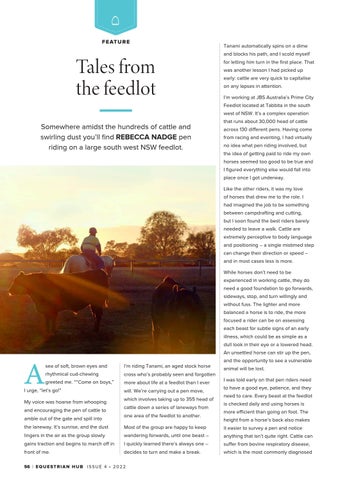F E AT U R E
Tales from the feedlot
Tanami automatically spins on a dime and blocks his path, and I scold myself for letting him turn in the first place. That was another lesson I had picked up early: cattle are very quick to capitalise on any lapses in attention. I’m working at JBS Australia’s Prime City Feedlot located at Tabbita in the south west of NSW. It’s a complex operation
Somewhere amidst the hundreds of cattle and swirling dust you’ll find REBECCA NADGE pen riding on a large south west NSW feedlot.
that runs about 30,000 head of cattle across 130 different pens. Having come from racing and eventing, I had virtually no idea what pen riding involved, but the idea of getting paid to ride my own horses seemed too good to be true and I figured everything else would fall into place once I got underway. Like the other riders, it was my love of horses that drew me to the role. I had imagined the job to be something between campdrafting and cutting, but I soon found the best riders barely needed to leave a walk. Cattle are extremely perceptive to body language and positioning – a single mistimed step can change their direction or speed – and in most cases less is more. While horses don’t need to be experienced in working cattle, they do need a good foundation to go forwards, sideways, stop, and turn willingly and without fuss. The lighter and more balanced a horse is to ride, the more focused a rider can be on assessing each beast for subtle signs of an early illness, which could be as simple as a dull look in their eye or a lowered head.
A
An unsettled horse can stir up the pen, sea of soft, brown eyes and
I’m riding Tanami, an aged stock horse
rhythmical cud-chewing
cross who’s probably seen and forgotten
greeted me. ““Come on boys,”
more about life at a feedlot than I ever
I urge, “let’s go!” My voice was hoarse from whooping and encouraging the pen of cattle to amble out of the gate and spill into
will. We’re carrying out a pen move, which involves taking up to 355 head of cattle down a series of laneways from one area of the feedlot to another.
and the opportunity to see a vulnerable animal will be lost. I was told early on that pen riders need to have a good eye, patience, and they need to care. Every beast at the feedlot is checked daily and using horses is more efficient than going on foot. The height from a horse’s back also makes
the laneway. It’s sunrise, and the dust
Most of the group are happy to keep
it easier to survey a pen and notice
lingers in the air as the group slowly
wandering forwards, until one beast –
anything that isn’t quite right. Cattle can
gains traction and begins to march off in
I quickly learned there’s always one –
suffer from bovine respiratory disease,
front of me.
decides to turn and make a break.
which is the most commonly diagnosed
56 | E Q U E S T R I A N H U B I S S U E 4 • 2 0 2 2























